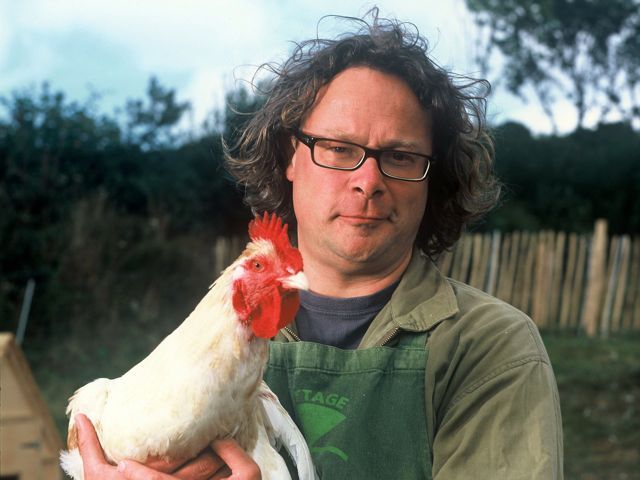1.17.11 In Defense of Meat
After seeing images of cows being dragged to slaughter, and then watching her father die from a "tennis-ball-sized" brain tumor she assumes is the result of a meat-based diet, Freston is now eating at Candle 79 and wearing Stella McCartney pleather shoes. I suppose this vegangelism is the inevitable backlash to the recent mania for meat (especially pork), but it seems like further evidence of the yo-yo dieting that is among the many unhealthy habits bringing this country to its dimpled and diabetic knees.
I admit, it's tough to know where to turn for "the truth." And if local, humanely-raised meat and poultry are not available to you—either logistically or financially—I can see how eating no meat at all might be a reasonable solution. I eat meat a few times a month, often preferring to use it as a supporting player to vegetable stars, and what I buy comes only from small, local farms. But it was discovering Hugh Fearnley-Whittingstall's seminal must-read, The River Cottage Meat Book, that gave me a fascinating new perspective on this whole question of To Meat Or Not To Meat.
It's important to bear in the mind that all of this stems from the assumption that the current state of industrial farming is intolerable, and that a return to more traditional pasturing is essential. This means that the animals we raise for meat must be allowed their dignity—to eat what is natural to them, to grow at a normal pace and to roam as they like. And it means that we, as their caretakers, are responsible for helping them to live and die as free from stress and pain as possible.I'm not going to be able to impart here all the wisdom of Hugh's polemic against the notion of vegetarianism, but I will paraphrase some of the meatiest bits.
Borrowing from Stephen Budiansky's 1992 book, The Covenant of the Wild, he talks about the symbiosis of domestication: how, literally thousands upon thousands of years ago, wild animals that began as camp followers became increasingly dependent upon human handouts of waste food and leftovers, until they entered into full domestication. In exchange (ultimately for their lives), they received protection from predators, assistance in bearing young and even rudimentary health care. What, he asks, would become of our domesticated animals if we were to stop eating them?
I realized that I had never pondered this, nor heard it mentioned in any vegangelical proselytizing, which generally stakes out an intractable moral high ground that is certainly understandable and possibly superior but not especially practical. Would we place our animals in some sort of retirement parks to die of old age? Would we then feed their carcasses to our dogs and cats—or must they become vegetarian, too? Or would we let our cows and goats and chickens loose to fend for themselves? Where would that be, when there is scarcely any "wilderness" left? How would we fertilize our crops? And if, by some miracle, the animals then "reverted" to a wild state, would their deaths at the hands (claws, teeth) of predators—mountain lions, foxes, coyotes—really be any more pleasant? I leave you with these questions and with the strong exhortation to invest in Hugh's mighty tome, which is as chock-full of sensible information and relevant philosophy as it is mouth-watering recipes. Like this one for steak tartare, a dish that, for obvious reasons, should only be made with beef raised with the utmost love and care.
Steak Tartare
- — 10 ounces humanely-raised rump or sirloin steak
- — 2 farm fresh egg yolks
- — 2 teaspoons minced shallots
- — 1 teaspoon salted capers, rinsed and chopped
- — 1 teaspoon chopped cornichons
- — 2 teaspoons chopped parsley
- — 1/2 teaspoon English mustard or prepared horseradish
- — Worcestershire sauce
- — Tabasco sauce
- — homemade ketchup
- — sea salt
- — fresh pepper
Trim the meat of all sinew and fat (except marbling), then process or mince it finely. A traditional way to do this is to scrape the meat with the blade of a knife, but I find that the resulting texture is too fine and almost like pâté.
Shape the meat into two equal mounds, and place on serving plates. Make a dip in the mounds and gently tip an egg yolk into each. Place all the other ingredients in individual bowls, take to the table and let people mix their own. Serve with Melba toast and/or hot French fries.
Suggested quantities to mix in per serving: 1 teaspoon shallots, ½ teaspoon capers, 1/2 teaspoon cornichons, 1 teaspoon parsley, ¼ teaspoon mustard, 3 shakes Worcestershire sauce, 4 drops Tabasco, ½ teaspoon ketchup, pinch of salt, and 3-4 grindings of pepper.
 Download Recipe
Download Recipe








4 Comments